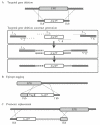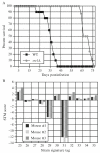Applying genetics and molecular biology to the study of the human pathogen Cryptococcus neoformans
- PMID: 20946836
- PMCID: PMC3611884
- DOI: 10.1016/S0076-6879(10)70033-1
Applying genetics and molecular biology to the study of the human pathogen Cryptococcus neoformans
Abstract
The basidiomycete yeast Crytococcus neoformans is a prominent human pathogen. It primarily infects immunocompromised individuals producing a meningoencephalitis that is lethal if untreated. Recent advances in its genetics and molecular biology have made it a model system for understanding both the Basidiomycota phylum and mechanisms of fungal pathogenesis. The relative ease of experimental manipulation coupled with the development of murine models for human disease allow for powerful studies in the mechanisms of virulence and host responses. This chapter introduces the organism and its life cycle and then provides detailed step-by-step protocols for culture, manipulation of the genome, analysis of nucleic acids and proteins, and assessment of virulence and expression of virulence factors.
Copyright © 2010 Elsevier Inc. All rights reserved.
Figures






Similar articles
-
Inositol Metabolism Regulates Capsule Structure and Virulence in the Human Pathogen Cryptococcus neoformans.mBio. 2021 Dec 21;12(6):e0279021. doi: 10.1128/mBio.02790-21. Epub 2021 Nov 2. mBio. 2021. PMID: 34724824 Free PMC article.
-
Cryptococcus neoformans: a sugar-coated killer with designer genes.FEMS Immunol Med Microbiol. 2005 Sep 1;45(3):395-404. doi: 10.1016/j.femsim.2005.06.005. FEMS Immunol Med Microbiol. 2005. PMID: 16055314 Review.
-
Identification and characterization of an SKN7 homologue in Cryptococcus neoformans.Infect Immun. 2005 Aug;73(8):5022-30. doi: 10.1128/IAI.73.8.5022-5030.2005. Infect Immun. 2005. PMID: 16041017 Free PMC article.
-
The vacuolar Ca²(+) exchanger Vcx1 is involved in calcineurin-dependent Ca²(+) tolerance and virulence in Cryptococcus neoformans.Eukaryot Cell. 2010 Nov;9(11):1798-805. doi: 10.1128/EC.00114-10. Epub 2010 Oct 1. Eukaryot Cell. 2010. PMID: 20889719 Free PMC article.
-
Iron and fungal pathogenesis: a case study with Cryptococcus neoformans.Cell Microbiol. 2008 Feb;10(2):277-84. doi: 10.1111/j.1462-5822.2007.01077.x. Epub 2007 Nov 27. Cell Microbiol. 2008. PMID: 18042257 Review.
Cited by
-
A Fungal Arrestin Protein Contributes to Cell Cycle Progression and Pathogenesis.mBio. 2019 Nov 19;10(6):e02682-19. doi: 10.1128/mBio.02682-19. mBio. 2019. PMID: 31744923 Free PMC article.
-
Ctr2 links copper homeostasis to polysaccharide capsule formation and phagocytosis inhibition in the human fungal pathogen Cryptococcus neoformans.PLoS One. 2010 Sep 2;5(9):e12503. doi: 10.1371/journal.pone.0012503. PLoS One. 2010. PMID: 20824073 Free PMC article.
-
Gene Expression of Diverse Cryptococcus Isolates during Infection of the Human Central Nervous System.mBio. 2021 Dec 21;12(6):e0231321. doi: 10.1128/mBio.02313-21. Epub 2021 Nov 2. mBio. 2021. PMID: 34724829 Free PMC article.
-
Survival in macrophages induces enhanced virulence in Cryptococcus.mSphere. 2024 Jan 30;9(1):e0050423. doi: 10.1128/msphere.00504-23. Epub 2023 Dec 11. mSphere. 2024. PMID: 38073033 Free PMC article.
-
Cryptococcus neoformans rapidly invades the murine brain by sequential breaching of airway and endothelial tissues barriers, followed by engulfment by microglia.bioRxiv [Preprint]. 2023 Nov 14:2023.11.13.564824. doi: 10.1101/2023.11.13.564824. bioRxiv. 2023. Update in: mBio. 2024 Apr 10;15(4):e0307823. doi: 10.1128/mbio.03078-23. PMID: 38014111 Free PMC article. Updated. Preprint.
References
-
- Bartlett KH, Kidd SE, Kronstad JW. The emergence of Cryptococcus gattii in British Columbia and the Pacific Northwest. Curr. Infect. Dis. Rep. 2008;10:58–65. - PubMed
-
- Bovers M, Hagen F, Boekhout T. Diversity of the Cryptococcus neoformans–Cryptococcus gattii species complex. Rev. Iberoam. Micol. 2008;25:S4–S12. - PubMed
-
- Casadevall A, Mukherjee J, Yuan R, Perfect J. Management of injuries caused by Cryptococcus neoformans—Contaminated needles. Clin. Infect. Dis. 1994;19:951–953. - PubMed
Publication types
MeSH terms
Substances
Grants and funding
LinkOut - more resources
Full Text Sources

